
BM-003
TRƯỜNG ĐẠI HỌC VĂN
LANG
ĐỀ THI KẾT THÚC HỌC PHẦN
KHOA NGOẠI NGỮ Học kỳ: 1 Năm học: 2021 - 2022
Mã học phần: 7NA0060 Tên học phần: Đọc-Viết- Ngữ Pháp 3
Mã nhóm lớp HP:
211_7NA0060_01
Thời gian làm bài: 100 (phút)
Hình thức thi: Trắc nghiệm kết hợp tự luận
Cách thức nộp bài phần tự luận (Giảng viên ghi rõ):
Gợi ý:
- SV gõ trực tiếp trên khung trả lời của hệ thống thi;
Lưu ý: Phần trắc nghiệm, không thay đổi thứ tự câu hỏi, các đáp án có thể trộn
PHẦN TRẮC NGHIỆM (5 điểm)
Passage 1: Read the passage and answer the questions.
THE SHAPE OF AFRICA
by Jared Diamond
The hope for Africa's future lies with its abundant human and natural resources.
A
Ask someone to tell you quickly what they associate with Africa and the answers you'll get
will probably range from "cradle of humankind" and "big animals" to "poverty" and
"tribalism." How did one continent come to embody such extremes?
B
Geography and history go a long way toward providing the explanations. Geographically,
Africa resembles a bulging sandwich. The sole continent to span both the north and south
temperate zones, it has a thick tropical core lying between one thin temperate zone in the
north and another in the south. That simple geographic reality explains a great deal about
Africa today.
C
As to its human history, this is the place where - some seven million years ago - the
evolutionary lines of apes and protohumans diverged. It remained the only continent our
ancestors inhabited until around two million years ago, when Homo erectus expanded out
of Africa into Europe and Asia. Over the next 1.5 million years, the populations of those
three continents followed such different evolutionary courses that they became distinct
species. Europe's became the Neandertals, Asia's remained Homo erectus, but Africa's
evolved into our own species, Homo sapiens. Sometime between 100,000 and 50,000 years
ago, our African ancestors underwent some further profound change. Whether it was the
development of complex speech or something else, such as a change in brain wiring, we
aren't sure. Whatever it was, it transformed those early Homo sapiens into what
paleoanthropologists call "behaviorally modern" Homo sapiens. Those people, probably
with brains similar to our own, expanded again into Europe and Asia. Once there, they
exterminated or replaced or interbred with Neandertals and Asia's hominins and became
the dominant human species throughout the world.
D

BM-003
In effect, Africans enjoyed not just one but three huge head starts over humans on other
continents. That makes Africa's economic struggles today, compared with the successes of
other continents, particularly puzzling. It's the opposite of what one would expect from the
runner first off the block. Here again, geography and history give us answers.
E
It turns out that the rules of the competitive race among the world's humans changed
radically about 10,000 years ago, with the origins of agriculture. The domestication of wild
plants and animals meant our ancestors could grow their own food instead of having to
hunt or gather it in the wild. That allowed people to settle in permanent villages, to
increase their populations, and to feed specialists - inventors, soldiers, and kings - who did
not produce food. With domestication came other advances, including the first metal tools,
writing, and state societies.
F
The problem is that only a tiny minority of wild plants and animals lend themselves to
domestication, and those few are concentrated in about half a dozen parts of the world. As
every schoolchild learns, the world's earliest and most productive farming arose in the
Fertile Crescent of southwestern Asia, where wheat, barley, sheep, cattle, and goats were
domesticated. While those plants and animals spread east and west in Eurasia, in Africa
they were stopped by the continent's north-south orientation. Crops and livestock tend to
spread much more slowly from north to south than from east to west because different
latitudes require adaptation to different climates, seasonalities, day lengths, and diseases.
Africa's own native plant species - sorghum, oil palm, coffee, millets, and yams - weren't
domesticated until thousands of years after Asia and Europe had agriculture. And Africa's
geography kept oil palm, yams, and other crops of equatorial Africa from spreading into
southern Africa's temperate zone. While South Africa today boasts the continent's richest
agricultural lands, the crops grown there are mostly northern temperate crops, such as
wheat and grapes, brought directly on ships by European colonists. Those same crops
never succeeded in spreading south through the thick tropical core of Africa.
G
The domesticated sheep and cattle of Fertile Crescent origins took about 5,000 years to
spread from the Mediterranean down to the southern tip of Africa. The continent's own
native animals - with the exception of guinea fowl and possibly donkeys and one breed of
cattle - proved impossible to domesticate. History might have turned out differently if
African armies, fed by barnyard-giraffe meat and backed by waves of cavalry mounted on
huge rhinos, had swept into Europe to overrun its mutton-fed soldiers mounted on puny
horses. That this didn't happen was no fault of the Africans; it was because of the kinds of
wild animals available to them.
H
Ironically, the long human presence in Africa is probably the reason the continent's species
of big animals survive today. African animals coevolved with humans for millions of years,
as human hunting prowess gradually progressed from the basic skills of our early
ancestors. That gave the animals time to learn a healthy fear of man and, with it, a healthy
avoidance of human hunters. In contrast, North and South America and Australia were
settled by humans only within the last tens of thousands of years. To the misfortune of the
big animals of those continents, the first humans they encountered were already fully
modern people, with modern brains and hunting skills. Most of those animals - woolly
mammoths, saber-toothed cats, and, in Australia, marsupials as big as rhinoceroses -
disappeared soon after humans arrived. Entire species may have been exterminated before

BM-003
they had time to learn to beware of hunters.
I
Unfortunately, the long human presence in Africa also encouraged something else to thrive
- diseases. The continent has a well-deserved reputation for having spawned some of our
nastiest ones: malaria, yellow fever, East African sleeping sickness, and AIDS. These and
many other human illnesses arose when microbes causing disease in animals crossed
species lines to evolve into a human disease. For a microbe already adapted to one species,
to adapt to another can be difficult and require a lot of evolutionary time. Much more time
has been available in Africa, cradle of humankind, than in any other part of the planet.
That's half the answer to Africa's disease burden; the other half is that the animal species
most closely related to humans - those whose microbes required the least adaptation to
jump species - are the African great apes and monkeys.
J
Africa continues to be shaped in other ways by its long history and its geography. Of
mainland Africa's ten richest countries - the only ones with annual per capita gross
domestic products over $3,300 - eight lie partly or entirely within its temperate zones:
Egypt, Libya, Tunisia, and Algeria in the north; and Angola, South Africa, Botswana, and
Namibia in the south. Gabon and Equatorial Guinea are Africa's only tropical countries to
make the list. In addition, nearly a third of the countries of mainland Africa (15 out of 47)
are landlocked, and the only African river navigable from the ocean for long distances
inland is the Nile. Since waterways provide the cheapest way to transport cumbersome
goods, geography again thwarts Africa's progress.
K
All these factors can lead to the question: "Is the continent, or at least its big tropical core,
doomed eternally to wars, poverty, and devastating diseases?" I'd answer, "Absolutely not."
On my own visits to Africa, I've been struck by how harmoniously ethnic groups live
together in many countries - far better than they do in many other parts of the globe.
Tensions arise in Africa, as they do elsewhere, when people see no other way out of
poverty except to fight their neighbors for dwindling resources. But many areas of Africa
have an abundance of resources: The rivers of central Africa are great generators of
hydroelectric power; the big animals are a major source of ecotourism revenue in eastern
and southern Africa; and the forests in the wetter regions, if managed and logged
sustainably, would be renewable and lucrative sources of income.
L
As for Africa's health problems, they can be greatly alleviated with the right planning and
funding. Within the past half century, several formerly poor countries in Asia recognized
that tropical diseases were a major drain on their economies. By investing in public health
measures, they have successfully curbed those diseases, and the increased health of their
people has led to far healthier economies. Within Africa itself, some international mining
and oil companies have been funding successful public health programs throughout their
concession areas because they realized that protecting the health of their workers was an
excellent business investment for them.
M
What's the best case for Africa's future? If the continent can overcome its health problems
and the corruption that plagues many of its governments and institutions, then it could take
advantage of today's globalized, technological world in much the same way that China and
India are now doing. Technology could give Africa the connections that its geography,
particularly its rivers, long denied it. Nearly half of all African countries are English

BM-003
speaking - an advantage in trade relations - and an educated, English-speaking workforce
could well attract service jobs to many African countries.
N
If Africa is to head into a bright future, outside investment will continue to be needed, at
least for a time. The cost of perpetual aid to or military intervention in Africa is thousands
of times more expensive than solving health problems and supporting local development,
thereby heading off conflicts. Not only Africans but the rest of us will be healthier and
safer if Africa's nations increasingly take their places as peaceful and prospering members
of the world community
1. If someone travels from the northernmost part of Africa to the southernmost, one would
experience _______________.
A. a moderate climate, then a hot climate, then a moderate climate again
B. a hot climate and then gradually cooler temperatures
C. a moderate climate, then a very cold one
D. very hot climate, then a moderate climate, then a hot climate again
ANSWER: A
2. What is the main idea of paragraph A?
A. There are several divergent opinions about Africa.
B. Most people have very little information about Africa.
C. Most people have incorrect impressions of Africa.
D. The author agrees with two of these opinions about Africa.
ANSWER: A
3. Which of the following is NOT true?
A. "Behaviorally modern" Homo sapiens originated in Asia.
B. Homo erectus originated in Africa.
C. Homo sapiens originated in Africa.
D. Neandertals originated in Europe.
ANSWER: A
4. In the last sentence of paragraph C, the word they refers to _______________.
A. "behaviorally modern" Homo sapiens
B. paleoanthropologists
C. Neandertals
D. Asia's hominins
ANSWER: A
5. In paragraph E, which of these is NOT mentioned as a result of the beginning of
agriculture?
A. people started to learn how to avoid diseases
B. people no longer needed to hunt their own food
C. people were able to develop specialized skills
D. people could settle in one place
ANSWER: A
6. Why did the crops grown in southwestern Asia spread to Europe but not Africa?

BM-003
A. It is more difficult for crops to spread south than it is east or west.
B. European colonists brought the crops home after visiting Asia.
C. African farmers preferred to grow Africa's own native plant species.
D. The distance to Africa was much further.
ANSWER: A
7. The author implies that African armies might have defeated European armies if
______________.
A. African animals were easier to domesticate
B. African soldiers were mounted on horses
C. sheep and cattle had been native to Africa
D. African soldiers had metal weapons
ANSWER: A
8. According to paragraph J, which of the following is true?
A. Most of the more prosperous countries are in Africa's temperate zones.
B. Most of Africa's ten richest countries are in the north of the continent.
C. Most countries in Africa have no coastline.
D. Of Africa's ten richest countries, none are from the tropical region.
ANSWER: A
9. The word dwindling in paragraph K is closest in meaning to _______________.
A. shrinking
B. evolving
C. developing
D. increasing
ANSWER: A
10. What is the main idea of this entire passage?
A. The geography and history of Africa has shaped its development.
B. Tropical diseases have been an enormous drain on Africa's economy.
C. The spread of species from east to west was faster than the spread from north to south.
D. Investments in Africa may halt conflicts and help development.
ANSWER: A
Passage 2: Read the passage and decide whether each statement below is TRUE,
FALSE, or NOT GIVEN.
WHY CAPE TOWN IS RUNNING OUT OF WATER
by Craig Welch, March 2018
By summer, four million people in the city of Cape Town - one of Africa's most affluent
metropolises - may have to stand in line surrounded by armed guards to collect rations of
the region's most precious commodity: drinking water.
Population growth and a record drought, perhaps exacerbated by climate change, is
sparking one of the world's most dramatic urban water crises, as South African leaders
warn that residents are increasingly likely to face "Day Zero." That's the day, previously

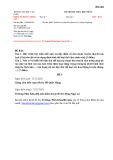

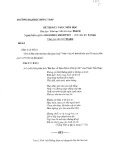
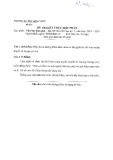
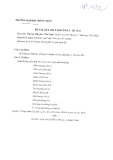
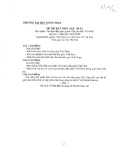
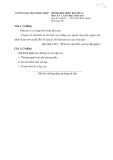
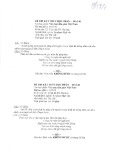
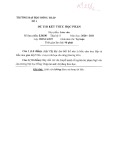
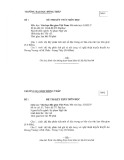
![Bộ câu hỏi trắc nghiệm Văn bản tiếng Việt [chuẩn nhất]](https://cdn.tailieu.vn/images/document/thumbnail/2025/20251127/thuynhung051106@gmail.com/135x160/24021764296609.jpg)


![Bài giảng Ngôn ngữ học đối chiếu Nguyễn Ngọc Chinh [PDF]](https://cdn.tailieu.vn/images/document/thumbnail/2025/20251101/vovu03/135x160/7471762139652.jpg)







![Ngân hàng câu hỏi môn Tiếng Việt thực hành [chuẩn nhất]](https://cdn.tailieu.vn/images/document/thumbnail/2025/20251003/kimphuong1001/135x160/21861759464951.jpg)
![Bài giảng Văn học phương Tây và Mỹ Latinh [Tập hợp]](https://cdn.tailieu.vn/images/document/thumbnail/2025/20251003/kimphuong1001/135x160/31341759476045.jpg)


